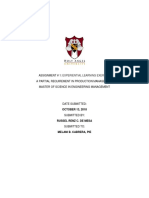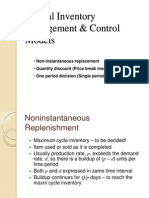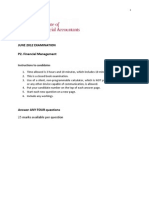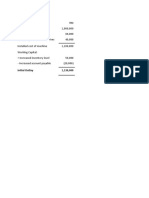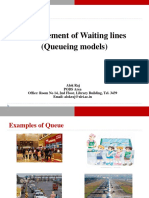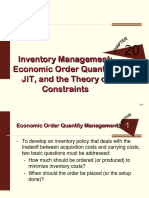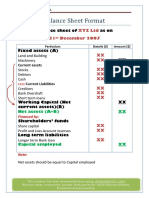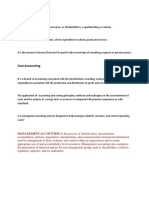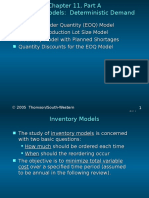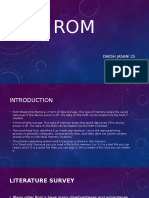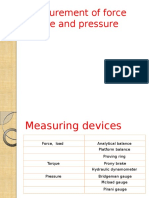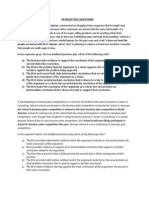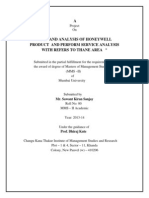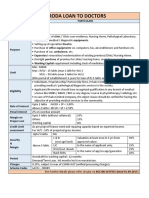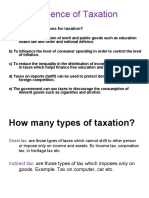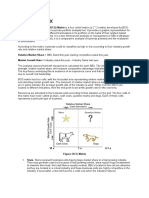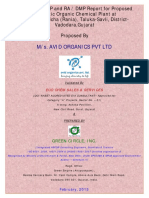Inventory Models:
Deterministic Demand
Economic Order Quantity (EOQ) Model
Economic Production Lot Size Model
Quantity Discounts for the EOQ Model
�Inventory Models
The study of inventory models is concerned
with two basic questions:
How much should be ordered each time
When should the reordering occur
The objective is to minimize total variable
cost over a specified time period (assumed to
be annual in the following review).
Inventory Costs
Ordering cost -- salaries and expenses of
processing an order, regardless of the order
quantity
Holding cost -- usually a percentage of the value of
the item assessed for keeping an item in inventory
(including finance costs, insurance, security costs,
taxes, warehouse overhead, and other related
variable expenses)
Backorder cost -- costs associated with being out of
stock when an item is demanded (including lost
goodwill)
Purchase cost -- the actual price of the items
Other costs
�Deterministic Models
The simplest inventory models assume
demand and the other parameters of the
problem to be deterministic and constant.
The deterministic models covered in this
chapter are:
Economic order quantity (EOQ)
Economic production lot size
EOQ with planned shortages
EOQ with quantity discounts
�Economic Order
Quantity (EOQ)
The most basic of the deterministic inventory
models is the economic order quantity (EOQ) .
The variable costs in this model are annual
holding cost and annual ordering cost.
For the EOQ, annual holding and ordering
costs are equal.
�Economic Order Quantity
Assumptions
Demand is constant throughout the year at D
items per year.
Ordering cost is $Co per order.
Holding cost is $Ch per item in inventory per year.
Purchase cost per unit is constant (no quantity
discount).
Delivery time (lead time) is constant.
Planned shortages are not permitted.
�Economic Order
Quantity
Formulas
Optimal order quantity: Q * =
Number of orders per year: D/Q *
Time between orders (cycle time): Q */D years
Total annual cost: [(1/2)Q *Ch] + [DCo/Q *]
(holding + ordering)
2DCo/Ch
�Example: Barts
Barometer Business
Economic Order Quantity Model
Bart's Barometer Business is a retail outlet that
deals exclusively with weather equipment.
Bart is trying to decide on an inventory
and reorder policy for home barometers.
Barometers cost Bart $50 each and
demand is about 500 per year distributed
fairly evenly throughout the year.
�Example: Barts
Barometer Business
Economic Order Quantity Model
Reordering costs are $80 per order and
holding
costs are figured at 20% of the cost of the
item. BBB is
open 300 days a year (6 days a week and
closed two
weeks in August). Lead time is 60 working
days.
�Example: Barts
Barometer Business
Total Variable Cost Model
Total Costs
= (Holding Cost) + (Ordering Cost)
TC
= [Ch(Q/2)] + [Co(D/Q)]
= [.2(50)(Q/2)] + [80(500/Q)]
= 5Q + (40,000/Q)
�Example: Barts
Barometer Business
Optimal Reorder Quantity
Q*=
2DCo /Ch =
2(500)(80)/10 = 89.44 90
Optimal Reorder Point
Lead time is m = 60 days and daily demand is
d = 500/300 or 1.667.
Thus the reorder point r = (1.667)(60) = 100. Bart
should reorder 90 barometers when his inventory
position reaches 100 (that is 10 on hand and one
outstanding order).
�Example: Barts
Barometer Business
Number of Orders Per Year
Number of reorder times per year = (500/90) =
5.56 or once every (300/5.56) = 54 working days
(about every 9 weeks).
Total Annual Variable Cost
TC = 5(90) + (40,000/90) = 450 + 444 = $894
�Example: Barts
Barometer Business
Well now use a spreadsheet to implement
the Economic Order Quantity model. Well confirm
our earlier calculations for Barts problem and
perform some sensitivity analysis.
This spreadsheet can be modified to accommodate
other inventory models presented in this chapter.
�Example: Barts
Barometer Business
Partial Spreadsheet with Input Data
Example: Barts
Barometer Business
Partial Spreadsheet Showing Formulas for Output
Partial Spreadsheet Showing Formulas for Output
A
1 0
E c o n . O rd e r Q n ty .
1 1
R e q u e s t. O rd e r Q n ty
1 2
C h a n g e
fr o m
E O Q
1 4
A n n u a l H o ld in g
C o s t
1 5
= S Q R T (2 * B 3 * B 4 /(B 5 * B 6 /1 0 0 ))
= (C 1 1 /B 1 0 -1 )* 1 0 0
1 3
= B 5 /1 0 0 *B 6 *B 1 0 /2
= B 5 /1 0 0 *B 6 *C 1 1 /2
A n n u a l O rd e r. C o s t
= B 4 *B 3 /B 1 0
= B 4 *B 3 /C 1 1
1 6
T o t. A n n . C o s t (T A C )
= B 1 4 + B 1 5
= C 1 4 + C 1 5
1 7
O ve r M in im u m
T A C
= (C 1 6 /B 1 6 -1 )* 1 0 0
1 8
1 9
M a x . In v e n t o r y
2 0
A v g . In v e n t o r y
2 1
L e ve l
= B 1 0
= C 1 1
= B 1 0 /2
= C 1 1 /2
R e o rd e r P o in t
= B 3 /B 7 *B 8
= B 3 /B 7 *B 8
2 3
N o . o f O rd e rs /Y e a r
= B 3 /B 1 0
= B 3 /C 1 1
2 4
C y c le
= B 1 0 /B 3 *B 7
= C 1 1 /B 3 *B 7
L e ve l
2 2
T im e
(D a y s )
�Example: Barts
Barometer Business
Partial Spreadsheet Showing Output
A
1 0
E c o n . O rd e r Q n ty .
1 1
R e q u e s t. O rd e r Q n ty .
1 2
C h a n g e
fr o m
E O Q
1 4
A n n u a l H o ld in g
C o s t
1 5
C
8 9 .4 4
7 5 .0 0
-1 6 .1 5
1 3
$ 4 4 7 .2 1
$ 3 7 5 .0 0
A n n u a l O rd e r. C o s t
$ 4 4 7 .2 1
$ 5 3 3 .3 3
1 6
T o t. A n n . C o s t (T A C )
$ 8 9 4 .4 3
$ 9 0 8 .3 3
1 7
O ve r M in im u m
T A C
1 .5 5
1 8
1 9
M a x . In v e n t o r y
2 0
A v g . In v e n t o r y
2 1
R e o rd e r P o in t
L e ve l
L e ve l
8 9 .4 4
7 5
4 4 .7 2
3 7 .5
1 0 0
1 0 0
5 .5 9
6 .6 7
5 3 .6 7
4 5 .0 0
2 2
2 3
N o . o f O rd e rs /Y e a r
2 4
C y c le
T im e
(D a y s )
�Example: Barts
Barometer Business
Summary of Spreadsheet Results
A 16.15% negative deviation from the EOQ
resulted in only a 1.55% increase in the Total
Annual Cost.
Annual Holding Cost and Annual Ordering Cost
are no longer equal.
The Reorder Point is not affected, in this model,
by a change in the Order Quantity.
�Economic Production
Lot Size
The economic production lot size model is a variation
of the basic EOQ model.
A replenishment order is not received in one lump
sum as it is in the basic EOQ model.
Inventory is replenished gradually as the order is
produced (which requires the production rate to be
greater than the demand rate).
This model's variable costs are annual holding cost
and annual set-up cost (equivalent to ordering cost).
For the optimal lot size, annual holding and set-up
costs are equal.
�Economic Production Lot
Size
Assumptions
Demand occurs at a constant rate of D items per
year.
Production rate is P items per year (and P > D ).
Set-up cost: $Co per run.
Holding cost: $Ch per item in inventory per year.
Purchase cost per unit is constant (no quantity
discount).
Set-up time (lead time) is constant.
Planned shortages are not permitted.
�Economic Production Lot
Size
Formulas
Optimal production lot-size:
Q*=
2DCo /[(1-D/P )Ch]
Number of production runs per year: D/Q *
Time between set-ups (cycle time): Q */D years
Total annual cost: [(1/2)(1-D/P )Q *Ch] + [DCo/Q *]
(holding + ordering)
�Example: Non-Slip Tile
Co.
Economic Production Lot Size Model
Non-Slip Tile Company (NST) has been using
production runs of 100,000 tiles, 10 times per year
to meet the demand of 1,000,000 tiles
annually. The set-up cost is $5,000 per
run and holding cost is estimated at
10% of the manufacturing cost of $1
per tile. The production capacity of
the machine is 500,000 tiles per month. The factory
is open 365 days per year.
�Example: Non-Slip Tile
Co.
Total Annual Variable Cost Model
This is an economic production lot size problem with
D = 1,000,000, P = 6,000,000, Ch = .10, Co = 5,000
TC
= (Holding Costs) + (Set-Up Costs)
= [Ch(Q/2)(1 - D/P )] + [DCo/Q]
= .04167Q + 5,000,000,000/Q
�Example: Non-Slip Tile
Co.
Optimal Production Lot Size
Q*=
2DCo/[(1 -D/P )Ch]
2(1,000,000)(5,000) /[(.1)(1 - 1/6)]
346,410
Number of Production Runs Per Year
D /Q * =
2.89
times per year
Example: Non-Slip Tile
Co.
Total Annual Variable Cost
How much is NST losing annually by using their present
production schedule?
Optimal TC
= $28,868
Current TC
= $54,167
Difference
= .04167(346,410) + 5,000,000,000/346,410
= .04167(100,000) + 5,000,000,000/100,000
= 54,167 - 28,868 = $25,299
�Example: Non-Slip Tile
Co.
Idle Time Between Production Runs
There are 2.89 cycles per year. Thus, each cycle lasts
(365/2.89) = 126.3 days. The time to produce 346,410 per
run = (346,410/6,000,000)365 = 21.1 days.
Thus, the
machine is idle for:
126.3 - 21.1 =
105.2
days between runs.
�Example: Non-Slip Tile
Co.
Maximum Inventory
Current Policy:
Maximum inventory = (1-D/P )Q *
= (1-1/6)100,000 83,333
Optimal Policy:
Maximum inventory = (1-1/6)346,410 = 288,675
Machine Utilization
Machine is producing D/P =
1/6
of the time.
�EOQ with Quantity
Discounts
The EOQ with quantity discounts model is
applicable where a supplier offers a lower purchase
cost when an item is ordered in larger quantities.
This model's variable costs are annual holding,
ordering and purchase costs.
For the optimal order quantity, the annual holding
and ordering costs are not necessarily equal.
EOQ with Quantity
AssumptionsDiscounts
Demand occurs at a constant rate of D items/year.
Ordering Cost is $Co per order.
Holding Cost is $Ch = $CiI per item in inventory
per year (note holding cost is based on the cost of
the item, Ci).
Purchase Cost is $C1 per item if the quantity
ordered is between 0 and x1, $C2 if the order
quantity is between x1 and x2 , etc.
Delivery time (lead time) is constant.
Planned shortages are not permitted.
�EOQ with Quantity
Discounts
Formulas
Optimal order quantity: the procedure for
determining Q * will be demonstrated
Number of orders per year: D/Q *
Time between orders (cycle time): Q */D years
Total annual cost: [(1/2)Q *Ch] + [DCo/Q *] + DC
(holding + ordering + purchase)
�Example: Nick's Camera
EOQ with Quantity Shop
Discounts Model
Nick's Camera Shop carries Zodiac instant print
film. The film normally costs Nick $3.20
per roll, and he sells it for $5.25. Zodiac
film has a shelf life of 18 months.
Nick's average sales are 21 rolls per
week. His annual inventory holding
cost rate is 25% and it costs Nick $20 to place an
order
with Zodiac.
�Example: Nick's Camera
Shop
EOQ with Quantity Discounts Model
If Zodiac offers a 7% discount on orders of
400
rolls or more, a 10% discount for 900 rolls or
more,
and a 15% discount for 2000 rolls or more,
determine
Nick's optimal order quantity.
-------------------D = 21(52) = 1092; Ch = .25(Ci); Co = 20
�Example: Nick's Camera
Shop
Unit-Prices Economical
Order Quantities
For C4 = .85(3.20) = $2.72
To receive a 15% discount Nick must order
at least 2,000 rolls. Unfortunately, the film's shelf
life is 18 months. The demand in 18 months (78
weeks) is 78 x 21 = 1638 rolls of film.
If he ordered 2,000 rolls he would have to
scrap 372 of them. This would cost more than the
15% discount would save.
�Example: Nick's Camera
Shop
Unit-Prices Economical
Order Quantities
For C3 = .90(3.20) = $2.88
Q3* = 2DCo/Ch =
2(1092)(20)/[.25(2.88)] = 246.31
(not feasible)
The most economical, feasible quantity for C3 is 900.
For C2 = .93(3.20) = $2.976
Q2* = 2DCo/Ch = 2(1092)(20)/[.25(2.976)] = 242.30
(not feasible)
The most economical, feasible quantity for C2 is 400.
Example: Nick's Camera
Shop
Unit-Prices Economical
Order Quantities
For C1 = 1.00(3.20) = $3.20
Q 1* =
2DCo/Ch = 2(1092)(20)/.25(3.20) = 233.67
(feasible)
When we reach a computed Q that is feasible we stop
computing Q's. (In this problem we have no more to
compute anyway.)
�Example: Nick's Camera
Shop
Total Cost Comparison
Compute the total cost for the most economical, feasible order
quantity in each price category for which a Q * was computed.
TCi = (1/2)(Qi*Ch) + (DCo/Qi*) + DCi
TC3 = (1/2)(900)(.72) +((1092)(20)/900)+(1092)(2.88) = 3493
TC2 = (1/2)(400)(.744)+((1092)(20)/400)+(1092)(2.976) = 3453
TC1 = (1/2)(234)(.80) +((1092)(20)/234)+(1092)(3.20) = 3681
Comparing the total costs for 234, 400 and 900, the lowest total
annual cost is $3453. Nick should order 400 rolls at a time.



